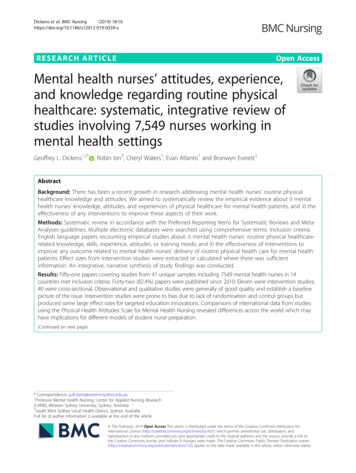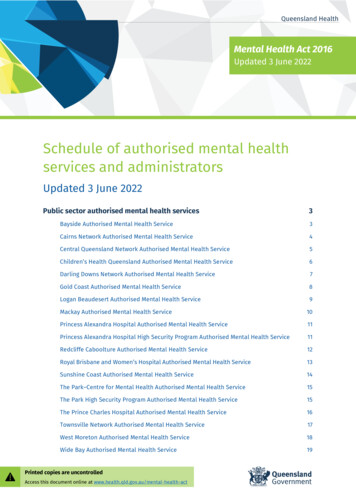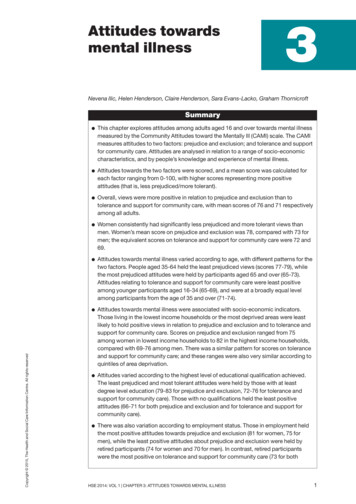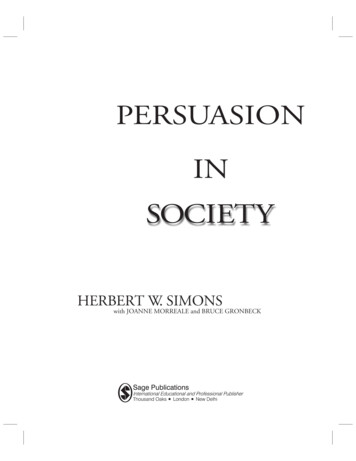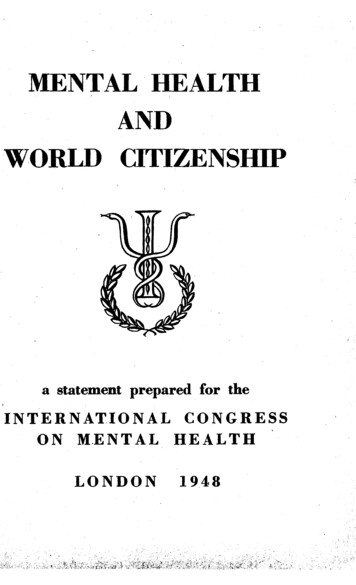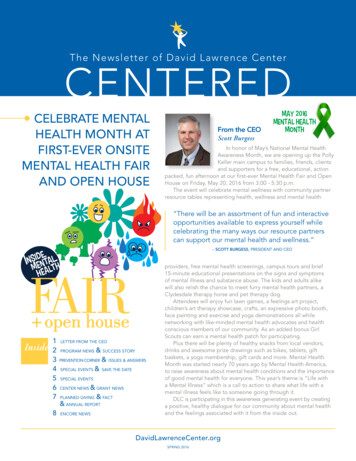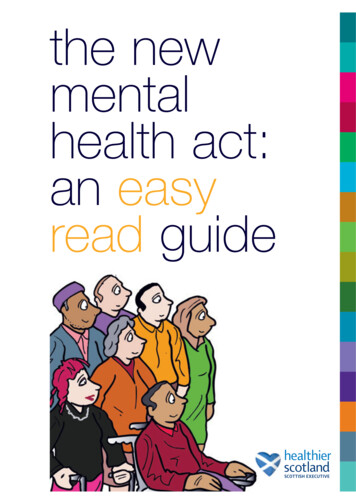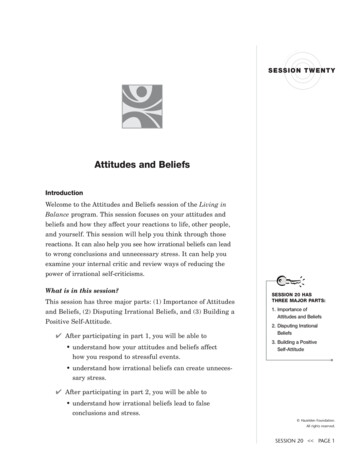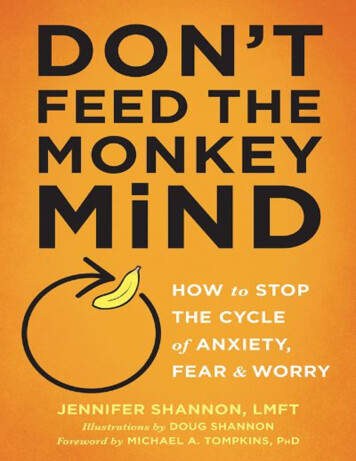
Transcription
“If you are ready to turn the tables on your anxiety, you can findno better book than Don’t Feed the Monkey Mind. Jennifer Shannonwill help you turn away from the enticing tactics of fearful worry andteach you how to return to the life you love.”—Reid Wilson, PhD, author of Stopping the Noise in Your Head“This book is a gem for people seeking to tame runaway anxietyand upset. Jennifer Shannon takes the simple metaphor of ‘monkeymind’ and fleshes it out with wisdom and simple steps that anyonecan follow. Here, in plain language, is a comprehensive set ofconcrete steps to let your anxiety run its course and then fade.Jennifer Shannon has blended the best of cognitive behavioralmethods and acceptance and commitment therapy (ACT) to producea great contribution to the self-help literature. Here you can learn toreturn your energy and attention back to your voyage through life,rather than the worries and fears that have hijacked your focus.Professional psychotherapists will also find it useful. I highlyrecommend it!”—David Carbonell, PhD, Chicago-based psychologistspecializing in treating fears and phobias; author of Panic AttacksWorkbook and The Worry Trick; and “coach” atwww.anxietycoach.com“Don’t Feed the Monkey Mind is clear and easy to understand.The book will teach you simple and powerful strategies to harnessfear and worry. Jennifer Shannon teaches you how to transform yourlife by taking the ‘monkey’ out of your mind.”—Dennis Greenberger, PhD, coauthor of Mind Over Mood“Don’t Feed the Monkey Mind begins with a well-written synopsisof basic attitudes and mental habits that perpetuate anxiety. The
book follows with a set of clear, concise changes in mind-set andbehavioral strategies to overcome anxiety at its roots. The ‘monkeymind’ concept is an apt, original contribution. Examples of pointsprovided by the author as well as references to her personal storyhelp make the book accessible to readers of all kinds.”—Edmund J. Bourne, PhD, author of The Anxiety & PhobiaWorkbook and Coping with Anxiety
Publisher’s NoteThis publication is designed to provide accurate and authoritativeinformation in regard to the subject matter covered. It is sold with theunderstanding that the publisher is not engaged in renderingpsychological, financial, legal, or other professional services. Ifexpert assistance or counseling is needed, the services of acompetent professional should be sought.Distributed in Canada by Raincoast BooksCopyright 2017 by Jennifer ShannonNew Harbinger Publications, Inc.5674 Shattuck AvenueOakland, CA 94609www.newharbinger.com“Worry Time” adapted from THE ANXIETY SURVIVAL GUIDEFOR TEENS by Jennifer Shannon, copyright 2015 by JenniferShannon. Used by permission of New Harbinger Publications, Inc.Illustrations by Doug ShannonCover design by Amy ShoupAcquired by Tesilya HanauerAll Rights ReservedLibrary of Congress Cataloging-in-Publication Data on file
ContentsForewordIntroductionCHAPTER 1: PERCEPTION OF THREATA Call to ActionPrimordial ThreatHijackedCHAPTER 2: THE THREE ASSUMPTIONSIntolerance of tySamanthaCHAPTER 3: FEEDING THE MONKEYFeeding the Mind-setMaria’s Intolerance of UncertaintyEric’s PerfectionismSamantha’s Over-responsibilityThe Downward CycleCHAPTER 4: PLAYING IT SAFEBehavior and Mental Strategies“I Must Be Certain” Strategies“I Cannot Make a Mistake” StrategiesOver-responsible StrategiesCommon Safety StrategiesDistractionTrying to RelaxCHAPTER 5: THE WORLD IS ROUNDBreaking the CycleBeyond Certainty
Beyond PerfectBeyond Over-responsibleA Bigger WorldCHAPTER 6: NECESSARY FEELINGSA Course to RunWelcoming Fight-or-Flight SensationsOpportunities to Practice WelcomingAsk for MoreIn ControlCHAPTER 7: MONKEY CHATTERThank the MonkeyWorry TimeMix and MatchCHAPTER 8: PURPOSE AND PLANValues at WorkCharting the CourseCHAPTER 9: LOWERING THE STAKESLevel OneCelebrating ImperfectionSeeking UncertaintyLetting Go of Over-responsibilityTaking OffCHAPTER 10: PRACTICING PRAISEPositive FocusProcess Over PayoffEric’s RefocusMaria’s Big ScoreSamantha’s Star QualityCo-coachingCruisingCHAPTER 11: THE EXPANDING LIFEAn Expansive Mind-setLiving with Purpose, Achieving Your Goals
Increased Compassion and Self-EsteemResilience to SetbacksRoom for PleasurePeace and PresenceKey Takeaways
ForewordWhat makes a great self-help book? Over these many years Ihave searched for the answer, and now I’ve found it in this book. Theformula comes down to three things: expert knowledge, a uniquespin on the subject, and most importantly, a deep understanding,beyond the professional, about the subject—in this case, anxiety,and what it is like to struggle with it.By her own admission, Jennifer Shannon knows her way aroundthe subject. Through her own personal struggle with anxiety, and heryears of professional practice, she has learned a few things that sheis eager to pass along to her readers. Her message is timely,perfectly suited for the anxiety-ridden society we live in.In this her third book, Jennifer presents her own unique spin onthe problem of anxiety and its treatment in straightforward, inspiringlanguage. Her central metaphor for the source of anxiety, themonkey mind, is an ancient one, but in her hands, it feels bothoriginal and fresh. In the first chapter she introduces the three basictricks the monkey mind plays on us, and the book takes off fromthere, describing a host of strategies that you can use to break thecycle of anxiety and calm that frisky creature within.Do not assume, however, that because Jennifer presents anxietymanagement strategies in a way that is fun and accessible that theyare less powerful. We have over thirty years of research that tell usthat these techniques are not smoke and mirrors. They are the realdeal.This book lays out a clear and consistent message that will helpyou overcome any kind of anxiety. If you are suffering, it will touchyou. Here is an author who mastered her own monkey mind and whonow wishes to help you master yours.—MT,P D
IntroductionThis book will show you, in a clear and memorable way, everythingyou need to know to alleviate your anxiety, worry, and stress.That’s a bold promise, and it’s one that I don’t take lightly. Onereason I feel qualified to make it is that I’m a therapist who hasspecialized in treating anxiety disorders for twenty years. My secondqualification is that I was not blessed with a relaxed, easygoingnervous system. Like you, I am hardwired for anxiety and worry.I was an anxious child as far back as I can remember—I’ll skipthe gory details about chronic nightmares, mysteriousstomachaches, and endless worrying. When my anxiety persisted asa young adult I turned to therapy for help. My therapist had apsychodynamic orientation, commonly known as “talk therapy,”which is based on the premise that our problems originate inchildhood and that once we have insight into them we naturallyprogress toward a healthier state. After a number of sessions, mytherapist and I theorized that my anxiety began with my relationshipwith a distant and critical father, and that I developed a fear of beingjudged and criticized. This and other similar insights were comfortingto me. It made good sense that I was anxious and it wasn’t my fault.My anxiety, however, continued.Several years later, shortly after the birth of my first child, Max, Istarted having panic attacks. If you’ve ever experienced a panicattack—almost 50% of the adult population has had at least one—you know what I mean when I say they are really, really horrible. Myentire body was seized with crippling fear, my heart pounded, and Igot almost instant diarrhea. My vision became distorted, my hearingwas altered—everything seemed unreal.Soon I was having panic attacks at random times throughout theday. Sometimes they woke me up in the middle of the night. Ithought I might be going crazy. I had a child to take care of and I wasbeginning my professional career as a therapist. I was terrified that
my panic attacks would interfere with the things that were mostimportant to me: raising a family and working. I knew I needed help.My new therapist and I decided that the responsibility of anewborn was probably what triggered my anxiety. We explored howmy past made me vulnerable for developing anxiety. Once again Iwas getting all sorts of insights. But the panic attacks just keptcoming.My therapist and I thought relaxation would help, so I committedmyself to practicing relaxation every day. I faithfully tried onerelaxation tape after another, thinking the next might do the trick.Still, there was no relief. I found someone who did biofeedback, atype of relaxation training where you are hooked up to a machinethat gives you an immediate reading as to how relaxed your body is.I was a very motivated participant, but still, the panic attacks came.I was desperate. Everything I was doing to figure out why thiswas happening to me and to stop it from happening was not working.I began to have serious doubts about my career choice. How could Ihelp others if I couldn’t help myself?Then in a local bookstore one day I saw a title that jumped off theshelf at me: Don’t Panic by Reid Wilson. I started to read it right thenand there, and within a few minutes I was standing in the aislefighting back tears of relief. I had finally found someone whounderstood what was happening to me.What I discovered from reading Wilson’s book was that thereason why I was having panic attacks was not nearly as importantas how I was reacting to them. My attempts to fix the problem—analyzing it, figuring it out, trying to get rid of it with relaxationtraining—were actually making things worse. I needed to respondcompletely differently to my panic attacks. Once I learned to take adifferent stance toward panic, I was able to cure myself from it.Don’t Panic was my first introduction to cognitive behavioraltherapy. CBT is not concerned so much with how your problemsdeveloped, but what is maintaining them now. Inspired by mypersonal experience, I retrained myself with books and workshops,and by consultation with some of the best CBT therapists in the field.
Changing my professional orientation to CBT has transformed myjob effectiveness and satisfaction immeasurably.It was not until later in my career that I realized that focusing onwhat is maintaining problems is not only effective for all types ofanxiety and depression, but for living a fuller, more self-actualizedlife. Whether you want to free yourself from a specific problem, likeme and my panic attacks, or you simply want to live a happier, moresuccessful, and more peaceful life, the tools to use are the same.I often tell my clients who suffer from anxiety disorders that theyare the lucky ones. They are lucky in the sense that, unlike mostpeople whose anxieties can be tolerated, their anxiety is too seriousto ignore. They have a real motivation to seek help. What I have toteach them will not only help them with their anxiety, it will help themwith whatever problems arise in the future.Do you have the motivation to change? If you do, read on!Everything you need to know is right here in this book.
Chapter 1Perception of ThreatDo you ever feel as though you were living your life hooked up toan IV drip of fear? 6:00 a.m.: I couldn’t get to sleep last night. Now I’llbe too groggy to be productive. 6:01 a.m.: Did I check whether thekids did their homework? 6:02 a.m.: God, I hope the market holds!And so on throughout your day.The fact is, you are living with a virtual IV drip of fear, a steadydose of stress hormones that you experience as anxiety and worry.It’s a prescription written for you and delivered to you by your ownbrain. And trying to do something about it has only made it worse.
This book will show you why you can’t control your anxiety.Indeed, it will show you that the very things you’ve been doing to tryto control your anxiety are actually what maintain your anxiety.Resisting, avoiding, and distracting yourself from your anxiety arebehaviors that send the wrong message to your brain. Thesebehaviors fuel a cycle of anxiety that always leads to a bigger dose. Icall it feeding the monkey. By the monkey, I mean the monkey mind,a metaphor as old as the behavior itself. Let me explain what I mean.For thousands of years, sages have likened the human mind to amonkey—leaping into thin air from one branch of thought to another,
never content, never at rest. Worries echo in our heads like so muchmonkey chatter. Powerful emotions have us jumping at anything thatpromises a little relief. Yet somehow relief always lies just beyondour reach.Whether due to genetic traits or traumatic life events, millions ofus suffer from excess anxiety. But regardless of what variety orintensity our anxiety manifests, there is one thing that is true for all ofus. We cannot relax and be at peace unless we feel safe. Humansand all other creatures, regardless of species, are first and foremostsurvival machines. Maintaining safety is, by necessity, our highestpriority. When we feel that our safety is at stake, everything else—appreciating the beauty and wonder of life, pursuing the heart’sdesires, or simply being “present in the moment”—becomesexpendable.Whether or not you believe your personal safety is at stake,you’ve been living as if it were. The way we anxious folks are wired,we don’t feel like we have any choice. In order to understand howthis has happened to us, let’s take a brief trip to what is sometimescalled the “fear center” of the brain.Deep within the core of your skull, at the top of your spinalcolumn, is a pair of almond-sized nuclei called the amygdalae. Allexperience—everything you see, smell, hear, touch, feel, or think—passes through the amygdalae like travelers passing through airportsecurity. There in the amygdalae each experience is instantly andautomatically screened for threat.When there is a perception of threat, the amygdalae set off analarm system that alerts their neighbors, the hypothalamus and theadrenal glands, which in turn send hormonal and neurologicalsignals to the sympathetic nervous system, instructing it toaccelerate the heart rate and breathing, bathe you in stresshormones, and shut down digestion and other unnecessary functions—in short, to go into survival mode.How we experience survival mode—what it feels like to us—iscrucial not only to our safety but to our sense of well-being.Depending on the perception of threat, we may experience thesealarms as uncomfortable physical sensations, like heart palpitations
and sweating, and negative emotions like fear, anger, and shame.These feelings are not conducive to our peace of mind. They canoverride everything else we want to think about and act upon—ineffect, they hijack the rest of the brain.If you are unable to enjoy the higher functions you are capable of—the ability to relax, to experience joy, to move toward your dreams—that alarm system is being overused. You are living with an IV dripof low-level negative emotion, otherwise known as anxiety. You aresurviving, but not thriving. Your purpose on earth is being trumped bythe misperceptions of threat and the false alarms of the amygdalaeor, to borrow the sages’ metaphor, the monkey mind.Why a monkey? Isn’t the source of our fear and anxiety more likea monster to be vanquished, a demon to be exorcised? Hardly. Thispart of your brain is a loyal, hardworking component dedicated toyour safety. It just gets a little wild and overreactive sometimes, like amonkey.
A Call to ActionImagine you are crossing a busy intersection on your way to work inthe morning when a truck runs a red light and heads straight in yourdirection. Instinctively, in a fraction of a second, you leap to the curb,out of the truck’s path. Your heart is pounding and your hand isshaking so hard your coffee is spattering on your sleeve. This is thefight-or-flight response, and while you may not enjoy the feeling, ithas kept us alive for thousands of years.
This early warning system is so quick and powerful that itoverrides the rest of your brain. Whatever else you were focusing on—watching the walk light, thinking about the meeting you areheading to—falls away so dealing with the threat can take centerstage. This is as it should be, for after all, the number one job of thebrain is staying alive. The fight-or-flight response is the call to actionof the monkey mind. Without it, we’d all be busy cliff diving andpetting snakes.As if keeping us safe were not a big enough responsibility, themonkey mind is also instrumental in performing the number two jobof the brain, that of keeping us connected to each other. In addition
to threats like charging wild boars, club-wielding rivals, and speedingtrucks, the monkey mind can recognize social threats to our survival.It’s hardwired to do so. Even in our earliest stage of life, infancy, wecan perceive safety or danger in the facial expressions of ourparents. Why is this necessary? We humans are thin-skinned,without sharp teeth or claws, and not very strong—what otherpredatory animals might call a soft target. We have always huntedand housed ourselves together in packs, so we can watch out foreach other. Your ancestors’ social status within their families andtribes was crucial to their survival.In order to protect your social status, your monkey mind is alwayswatching and listening to those around you, looking for signals tellingwhether you are respected, whether you are loved, and whether youbelong. If you are alienating your neighbors, irritating your friendsand family, or a subject of scorn to your community, even if you arenot aware of it, the monkey reads the signals and sounds the alarm.A serving of fear, with a side order of shame, will focus your attentionand remind you that you need to play well with others.Primordial ThreatThese two ever-present possibilities—death, and losing social statusor being kicked out of the tribe—are universal, what I call primordialthreats. The ability to recognize primordial threats is so importantthat it is built into our brains, part of our operating system. You don’thave to teach a toddler not to put her hand in the fire or walk off acliff. The ability to recognize heights, loud noises, snakes, baredteeth, and other dangerous situations as potential threats isuniversal. The hard-learned lessons of our ancestors arebequeathed to us in our DNA, informing the monkey mind’s ability toperceive threats and thus enabling humanity to survive.
Unfortunately, the monkey is also the source of all our modernanxieties. Why? Because when the monkey is presented withsomething it hasn’t been programmed to recognize, it has to guesswhether or not it’s a threat. For those of us with a lot of anxiety, ourmonkey mind’s guesses err on the side of safety. This makes forplenty of misperceptions.If on the day after your close call with a speeding truck, you findyourself standing anxiously at the curb, clutching your coffee, waitingfor the walk sign to turn, you may wonder why you’re feeling sojumpy. You remember the vivid image of that speeding, homicidal
truck clearly, but you know very well that incident was an anomaly.There is statistically little risk crossing the street when the walk signis on. Nevertheless, you are anxious. That’s because the monkeymind cannot do risk assessment. Just like a real monkey, it is nogood at math.When that memory of the oncoming truck flashes across yourmind, the monkey notices and makes a guess at your danger level.Without pausing to reflect (because it can’t reflect), it sounds thealarm. When the monkey mind hits the fear button, we are as simpleand single-minded as our forebears. Anxiety is a call to action. Themonkey is screaming, Woo-woo-woo! Something is wrong. Dosomething!How you react depends on how you’ve learned to react in thepast. You might stand frozen in fear for a few moments, waiting untilothers cross safely. You might avoid that corner in the future, or youmight white-knuckle your way across the street, shaming yourself foryour fear, muttering This is ridiculous!When the monkey uses its trump card, usually whatever we do isridiculous. Once your fight-or-flight reflex is activated, the chemicals,hormones, and emotions at work in your body hijack the rest of yourbrain.This is quite an accomplishment for such a little critter. Theprefrontal cortex, known as the executive brain, is the size of anelephant compared to the monkey mind. It’s the greatest cognitiveengine in history: the primary tool used in the writing of Hamlet,invention of the iPhone, and perhaps someday, a cure for cancer. Yetwith the help of a little anxiety, the monkey can make the elephantstand on its hind legs and trumpet its snout in terror. No matter howsmart you are, no matter how crystal clear your vision, everything isdistorted when viewed through the lens of fear.
HijackedWhen we are hijacked by the monkey mind, we make two simplemistakes. First, we overestimate the threat. What are the actual oddsof another homicidal truck appearing the moment you step into thestreet today? The chance is practically nil, but you’re trusting a wildguess of the monkey: Woo-woo-woo! Looks likely to me!
The second mistake is that we underestimate our ability to copewith both the negative emotions in the monkey’s alarm, and with thethreat should it actually occur. Whether we’re crossing the street orclimbing a ladder, accidents happen. When you attempt any task,you can fail. When you open your mouth to speak you may offendsomeone. But life doesn’t stop when threats manifest as reality. Wecope. We recover. We can learn from our mistakes and move on.Nor should life stop when we’re feeling the negative emotions andsensations of the monkey’s alarms.But many of us have our lives on hold. The ambient backgroundof anxiety keeps us paralyzed, unable to follow our dreams. Wespend our days—and for some of us, nights—reviewing the past forerrors and looking into the future to prevent making more. Wedebate decisions we’ve already made, recycle old concerns, indulgeendless regrets, obsess over things we can’t control. It’s all inresponse to a constant stream of negative feelings and monkeychatter. Woo-woo-woo! Something is wrong. Do something!We try to manage things. We check our smartphones or turn onthe TV. We pour ourselves a drink, we get a snack, we go shopping.We triple-check the report for errors. We say yes to things when wewant to say no. We look up symptoms on the Internet to reassureourselves the mole is not cancerous.These distractions and strategies offer only short-term relief. Themonkey mind is always on the job, hypervigilant, waiting for anopening. If you’ve ever tried meditating, and given up in frustration,you know exactly what I’m talking about. The moment your focuswavers, the monkey elbows in with something compelling to feelanxious about and occupy your mind.When it comes to the monkey mind, the cliché resistance is futileis actually true. The monkey mind is an ancient brain-within-a-brain—simple, focused, and hardwired to be autonomous, beyond ourdirect control. The monkey is always there, even when you mostwant to enjoy the moment without it—when you’re alone just trying torelax, when you’re in your lover’s arms, when you are trying topursue your dreams.
While this may sound discouraging, it is actually good news. Ifyou can conceptualize your anxiety as a false alarm, and youranxious thoughts as being like the chattering of a monkey, you havealready begun your healing. You understand that the monkey mind isa working part of you, but you are not the monkey.In cognitive behavioral therapy we call this defusion. Becomingaware of this difference de-fuses—creates a distance between—thepart of you that is hyperreactive to threat and the rational part of youthat can notice your thoughts, emotions, and bodily sensations, andlearn to override them when necessary. Working with patients, I’velearned that defusion is a lot easier when we conceptualize thesource of anxiety not as a monster within, but only as a frightenedlittle monkey trying to do its job.
This book will teach you how to develop resilience to themonkey’s alarms so that you can think and act clearly in situationswhere you are usually hijacked. Having more resilience will alsoallow you to be more resourceful and flexible when real threats arise.With practice you will eventually experience less anxiety, which Iimagine is why you are reading this book. And there’s a bonus.While following this practice you’ll also reclaim your personal valuesand reorient yourself toward what your heart desires.With your new awareness of the monkey mind, you’ve taken thefirst step on your path to recovery. You understand now that your
anxiety does not define you. It is a distinct part of you that is beyondyour direct control. Coming up, step two: recognizing how anxietyaffects your thinking. What happens to your point of view when youget hijacked by the monkey?Chapter 1 Takeaway
Our anxiety is a call to actiongenerated by the monkey mind’sperception of threat.
Chapter 2The Three AssumptionsOne morning several years ago I sat down with my laptop to beginwriting my first book: a workbook for teens with social anxiety. I’dnever attempted to write anything of this scale before and I couldhardly believe I was doing it. As a therapist I talked about anxietyevery day with my clients, but writing about it was a different matter.As I reached for the keyboard my heart began to race and mystomach clenched up. I’m not really sure how to say what I want tosay, I thought to myself, adding, and an author should be. Looking atmy fingers hovering above the keyboard, I noticed that my nailsneeded filing.What if my premise isn’t fully formed yet? I continued. What if myconceptualization is unsuitable for a book, or worse yet, just plainwrong? If I am wrong the whole world will know that I am a fraud! Isuddenly remembered an article I had meant to read. Would a bitmore research give me some clarity?If this book isn’t good I’ll disappoint my editor, my readers, andmy friends and family. I’ll let everybody down! I thought. At this pointmy hands were visibly trembling. Looking out the window I noticedthat someone really should pick up that dog poop in the backyard.None of the tasks that were calling me away from my laptop weretruly important or time sensitive. What made them suddenlycompelling was that both my body and my brain were telling me thatsomething was wrong. I was experiencing the very thing I consideredmyself an expert on: anxiety. I was hijacked.If we examine my anxious thoughts that morning, we canrecognize three assumptions I had made. First, I thought I had to becertain about what I was going to write. Second, I thought that if I gotanything wrong I would be exposed as a fraud. Third, I thought if thebook wasn’t successful I would disappoint everyone.
These three assumptions are universally shared by all anxiouspeople. (Yes, reader, as you know if you read the introduction, I amone of you!) Because they echo the survival agenda of the monkeymind, I call them collectively the monkey mind-set.Intolerance of uncertainty: I must be 100% certain.Perfectionism: I must not make mistakes.Over-responsibility: Ihappiness and safety.amresponsibleforeveryone’sThese assumptions are impossible standards. The more weattempt to live by them, the more anxious we will be, and the lesslikely we will be to take the risks that are necessary to take in orderto live freely and follow our dreams.That morning in the backyard, I stopped and took a look atmyself. To write this book is my heart’s desire, I thought. Why am Iholding a pooper scooper instead? The monkey mind-set seldomtakes us anywhere we want to go. In fact, it almost always holds usback from what we long for in life.
You will recognize at least one, if not all three of theseassumptions, as a central pillar of your own belief system. The first isparticularly widespread. In fact, you can’t be anxious without it!Intolerance of UncertaintyThe ability to plan for the future—to anticipate problems andopportunities—is one of the most important, if not the mostimportant, adaptations of our Homo sapiens brains. Whether the
issue is our health, our finances, or our family, we like to know whatlies ahead. What if I get sick? Will the market crash? Will my lovedones arrive safely? These are our constant concerns, and we planwith them in mind. But when does reasonable planning turn intoworry and obsession?Your monkey’s central mission—keeping you alive and safewithin your tribe—is best accomplished by eliminating all uncertainty.The monkey motto is What you don’t know might kill you. From itsperspective, the only time it’s safe for you to relax is when you cananticipate and control every outcome. Be certain or die!Yet the only thing we know for certain is that the sun will come uptomorrow. If we cannot tolerate not knowing what will unfold in thatmorning light, we won’t be able to sleep. Until we’ve eliminated everythreat, we will be unable to relax or feel any pleasure. We’ll agonizeover decisions because we think that with enough research andcaution we can always make the right choice. Presented with
something new, we’ll assume it is dangerous unless it’s proven to besafe. We’re always preparing for the worst because the worst isprobably just around the corner.This mind-set takes its toll. Constant hypervigilance keeps usworried and stressed—especially problematic at night when we aretrying to sleep. Making decisions is difficult because we believe weneed to be sure we are making the right one. Big decisions likechoosing a college or a job are paralyzing. Even something assimple as choosing a pair of shoes can become a labyrinth of prosand cons.Difficulty tolerating doubt can lead to compulsive checkingbehaviors like making sure doors are locked and appliances ar
monkey mind, is an ancient one, but in her hands, it feels both original and fresh. In the first chapter she introduces the three basic tricks the monkey mind plays on us, and the book takes off from there, describing a host of strategies that you can use to break the cycle of anxiety and calm that frisky creature within.

